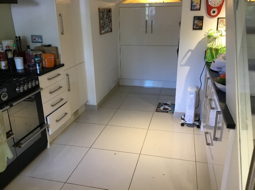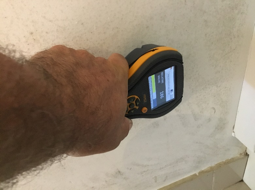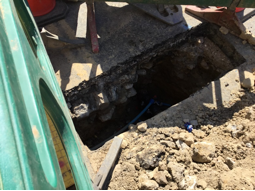The Brief
Following a leak from a mains water pipe, three properties in West Malling, Kent, suffered from water ingress into their basements. For this reason they were in need of a professional flood clean up service. We were called to site to scope and carry out required remedial work to minimise secondary damage. If a property is not dried out adequately, it can lead to mould growth and rot which can then lead to extensive and expensive repairs.
The basements of No. 15 and No. 19 have been turned into living areas, and No. 17’s basement was still being used as a storage area. All three basements were affected.
The Objective – Flood Restoration
The properties were built in the late 1800s and are privately owned. Built primarily of brick, the Kent terrace houses boast a pitched timber frame roof, completed with tiles. The properties all have rear gardens, although they do not have any front garden – the front door opens onto the public footpath and it is from the front where the water penetrated into the basements, which were now in need of flood clean up.



The Technical Part – Flood Damage Drying
No. 15:
The basement of No. 15 has been converted into a kitchen. The floor has a concrete base with ceramic tiles throughout which required complete and thorough sanitation. A section of the dry lined wall also required removing where mould had begun to grow.
Within the basement area, one of the walls had a WME reading of 21.2 and water tracked up to about 300mm. Wood Moisture Equivalent (WME) is the theoretical %mc (moisture content) value that would be attained by a piece of wood in contact with and in moisture equilibrium with the material under test. The higher the reading, the damper the material is, with 100% WME being the maximum value. As a general rule of thumb, a WME reading should be less than 17.5% WME.
Speak to our restoration experts now
01622 926 505Flood drying equipment needed to be installed to ensure an adequate dry out of the basement. One dehumidifier, along with one air mover to increase airflow was specified for this property.
No. 17:
No. 17’s basement was the only one of the three that was still being used as a storage area. Again, it consisted of a concrete floor and required full and thorough sanitation, as well as drying. One dehumidifier alongside one air mover was installed to dry out the area.
No. 19:
The second of the two basements which were converted to living areas, No. 19, required lower sections of plasterboard removing due to the water penetration. Plasterboard can bow, peel, stain, and encourage significant mould growth should it suffer from water damage.
As with the others, the whole basement area required thorough sanitation and a drying regime consisting of one dehumidifier and one air mover. And with that, our flood damage cleanup in Kent was complete.



